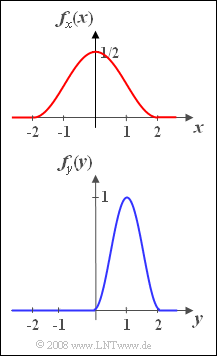Exercise 3.3: Moments for Cosine-square PDF
As in Exercise 3.1 and Exercise 3. 2 we consider the random variable restricted to the range of values from $-2$ to $+2$ with the following PDF in this section:
- $$f_x(x)= {1}/{2}\cdot \cos^2({\pi}/{4}\cdot { x}).$$
Next to this, we consider a second random variable $y$ that returns only values between $0$ and $2$ with the following PDF:
- $$f_y(y)=\sin^2({\pi}/{2}\cdot y).$$
- Both density functions are shown in the graph.
- Outside the ranges $-2 < x < +2$ resp. $0 < x < +2$ , the followings holds: $f_x(x) = 0$ resp. $f_y(y) = 0$.
- Both random variables can be taken as (normalized) instantaneous values of the associated random signals $x(t)$ or $y(t)$ respectively.
Hints:
- This exercise belongs to the chapter expected values and moments.
- To solve this problem, you can use the following indefinite integral:
- $$\int x^{2}\cdot {\cos}(ax)\,{\rm d}x=\frac{2 x}{ a^{ 2}}\cdot \cos(ax)+ \left [\frac{x^{\rm 2}}{\it a} - \frac{\rm 2}{\it a^{\rm 3}} \right ]\cdot \rm sin(\it ax \rm ) .$$
Questions
Solution
- The first statement is never true, as is evident from the Steiner's theorem .
- The second statement is only valid in the (trivial) special case $x = 0$.
However, there are also zero-mean random variables with asymmetric PDF.
- This means: Statement 6 is not always true.
(2) Because of the PDF symmetry with respect to $x = 0$ it follows that for the linear mean $m_x \hspace{0.15cm}\underline{= 0}$.
(3) Der Effektivwert des Signals $x(t)$ ist gleich der Streuung $\sigma_x$ bzw. gleich der Wurzel aus der Varianz $\sigma_x^2$.
- Since the random variable $x$ has mean $m_x {= 0}$ , the variance is equal to the root mean square according to Steiner's theorem.
- Dieser wird in Zusammenhang mit Signalen auch als die Leistung $($bezogen auf $1 \ \rm \Omega)$ bezeichnet. Somit gilt:
- $$\sigma_x^{\rm 2}=\int_{-\infty}^{+\infty}x^{\rm 2}\cdot f_x(x)\hspace{0.1cm}{\rm d}x=2 \cdot \int_{\rm 0}^{\rm 2} x^2/2 \cdot \cos^2({\pi}/4\cdot\it x)\hspace{0.1cm} {\rm d}x.$$
- With the relation $\cos^2(\alpha) = 0.5 \cdot \big[1 + \cos(2\alpha)\big]$ it follows:
- $$\sigma_x^2=\int_{\rm 0}^{\rm 2}{x^{\rm 2}}/{\rm 2} \hspace{0.1cm}{\rm d}x + \int_{\rm 0}^{\rm 2}{x^{\rm 2}}/{2}\cdot \cos({\pi}/{\rm 2}\cdot\it x) \hspace{0.1cm} {\rm d}x.$$
- These two standard integrals can be found in tables. One obtains with $a = \pi/2$:
- $$\sigma_x^{\rm 2}=\left[\frac{x^{\rm 3}}{\rm 6} + \frac{x}{a^2}\cdot {\cos}(a x) + \left( \frac{x^{\rm2}}{{\rm2}a} - \frac{1}{a^3} \right) \cdot \sin(a \cdot x)\right]_{x=0}^{x=2} \hspace{0.5cm} \rightarrow \hspace{0.5cm} \sigma_{x}^{\rm 2}=\frac{\rm 4}{\rm 3}-\frac{\rm 8}{\rm \pi^2}\approx 0.524\hspace{0.5cm} \Rightarrow \hspace{0.5cm}\sigma_x \hspace{0.15cm}\underline{\approx 0.722}.$$
(4) Correct is the first mentioned suggestion:
- The variant $y = 2x$ would yield a random size distributed between $-4$ and $+4$ .
- In the last proposition $y = x/2-1$ the mean $m_y = -1$ would wäre.
(5) From the graph on the specification sheet it is already obvious that $m_y \hspace{0.15cm}\underline{=+1}$ must hold.
(6) The mean value does not change the variance and dispersion.
- By compressing by the factor $2$ the scatter becomes smaller againstüber Teilaufgabe (3) also by this factor:
- $$\sigma_y=\sigma_x/\rm 2\hspace{0.15cm}\underline{\approx 0.361}.$$
